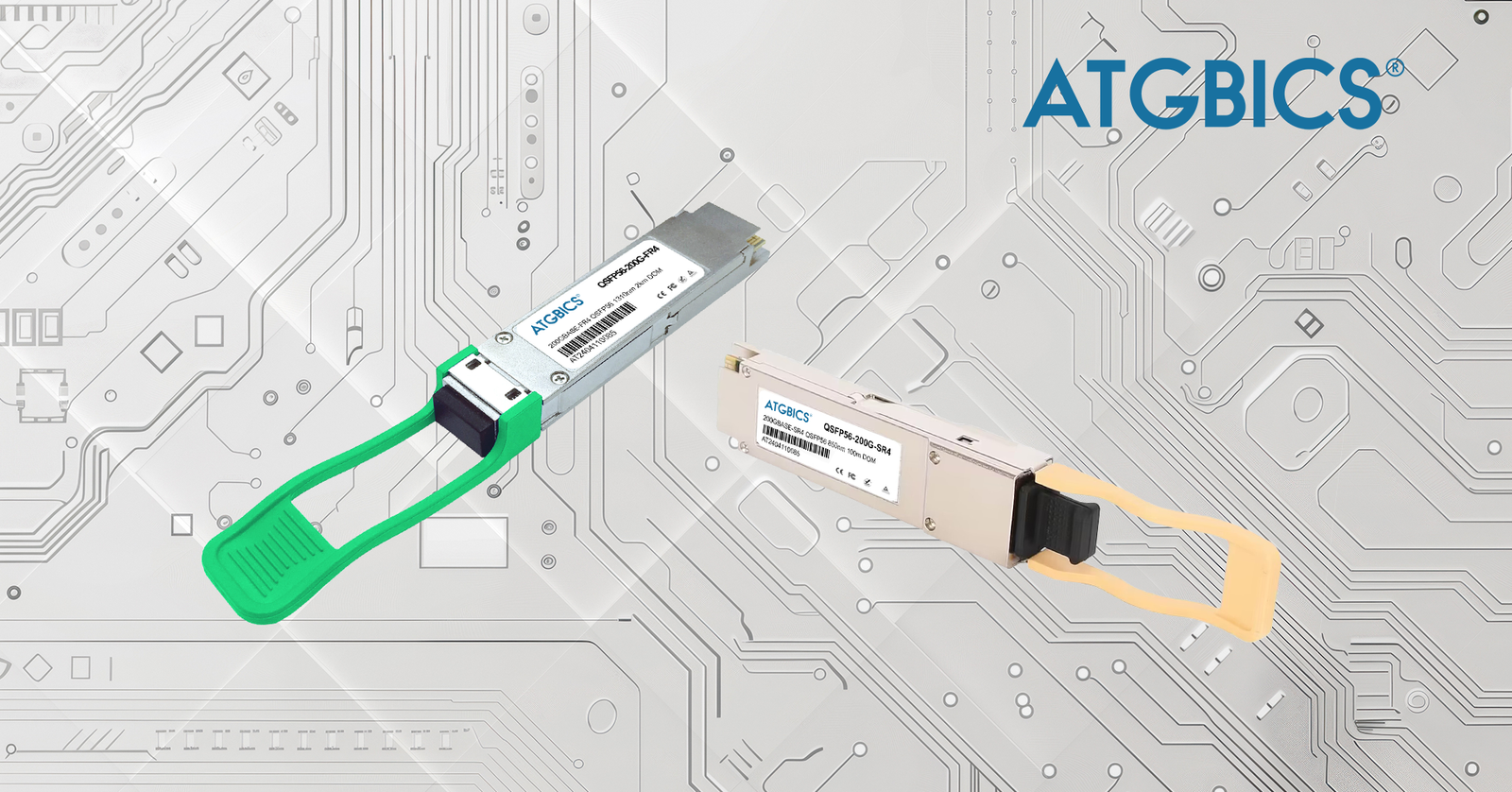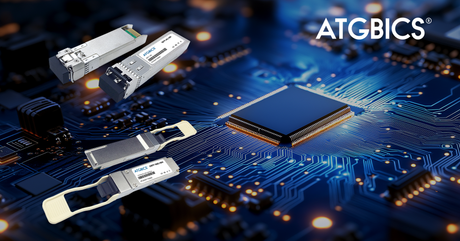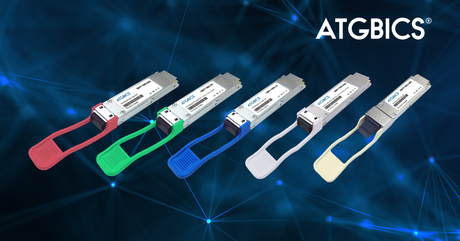200G transceivers are high speed modules capable of 200Gbps transmission speeds. They are common in high bandwidth, low latency environments such as data centres, telecom networks and cloud computing and come in two form factors: QSFP56 (Quad Small Form-factor Pluggable 56) and QSFP-DD (Quad Small Form-factor Pluggable – Double Density).
QSFP56
- Maximum power consumption typically ≤5W
- Backward compatible with QSFP+ and QSFP28
- 4x 50Gbps channels
- PAM4 Modulation
- Connectors – MPO-12, Duplex LC
The QSFP56 form factor was designed specifically for 200G Ethernet, following QSFP28 (100G). QSFP56 modules have four internal channels that run at 50Gbps – 56Gbps each, reaching a total data rate of 200Gbps. It achieves this higher speed by utilising PAM4 modulation rather than NRZ.
QSFP-DD
- Maximum power consumption typically ≤12W
- Backward compatible with QSFP+, QSFP28 and QSFP56
- 8x 25Gbps channels
- NRZ Modulation (for 200G speeds)
- Connectors – MPO-12, MPO-16, Duplex LC
- Also used in 400G & 800G
- IEEE802.3bs & QSFP-DD MSA compliance
QSFP-DD is used in many high speed applications ranging from 200G to 800G and beyond. Its similar design to other QSFP modules ensures backward compatibility, but unlike the others, it contains eight internal channels to allow for higher density transmission. For 200G applications, these eight lanes run at 25Gbps each using NRZ modulation. For 400G and 800G applications, PAM4 modulation is used to allow for higher data rates per lane.
Upgrading from 100G to 200G – Optical Fibre Connections
The existing cabling can be used when upgrading to 200G from 100G if the current 100G links use either of the below types of fibre connection:
- Duplex SMF with a maximum length of 2km - QSFP-200G-FR4 technology uses the same fibre type and connectors (duplex LC, SMF) as 100G-CWDM4, 100G-LR4, 100G-LRL4, 100G-DR, 100G-FR and 100G-LR.
- Parallel MMF with a maximum length of 70m for OM3, or 100m for OM4. QSFP-200G-SR4 uses the same fibre type and connectors (MPO-12, parallel MMF) as 100G-SR4, 100G-XSR4.
Dual rate 200G QSFP transceivers and direct attach can operate at 100G provided that the QSFP200 switch port that contains the transceiver is configured for 100G.
There is no industry standard for 200G over duplex MMF. QSFP200G-SR4 uses parallel multimode optical fibre using an MPO-12 optical connector. This is the same fibre type and fibre connector as used for QSFP100G-SR4.
The Difference Between NRZ and PAM4 Optical Modulation
NRZ stands for “Non-Return to Zero” modulation. It is an electrical or optical data channel where only two amplitude levels (or symbols) are allowed. One amplitude level represents a digital ‘1’ and the other level represents a digital ‘0’.
NRZ is the simplest way to transmit digital data and has been the predominant modulation method for transmitting data up to 25Gbps.

PAM-4 stands for “Pulse Amplitude Modulation 4-level”. The ‘4’ refers to the number of different amplitude levels (or symbols) of the electrical or optical signal carrying the digital data. Each symbol cycle can represent 2 bits of logical information (0, 1, 2, 3), that is, four levels in one time unit, twice as many bits as a NRZ waveform at the same symbol rate. This leads to greater transmission efficiency and lower Bit Error Rate (BER).

See our Knowledge Base for more information on these modulation types.
Optical Standards
|
Standard |
Form Factor |
Maximum Reach |
Wavelength |
Media |
|
SR4 |
QSFP56/QSFP-DD |
100m |
850nm |
MMF |
|
SR8 |
QSFP-DD |
100m |
850nm |
MMF |
|
DR4 |
QSFP-56 |
500m |
1310nm |
SMF |
|
FR4 |
QSFP56 |
2km |
1310nm |
SMF |
|
LR4 |
QSFP56/QSFP-DD |
10km |
1310nm |
SMF |
|
ER4 |
QSFP-DD |
40km |
1295.56 ~ 1309.14nm |
SMF |
|
SL4 |
QSFP56 |
30m |
850nm |
MMF |
|
PSM8 |
QSFP-DD |
2km |
1310nm |
SMF |
Benefits of 200G
200G transceivers offer a significant improvement in network speed, efficiency and scalability compared to more mainstream 100G technology. Their backward compatibility enables seamless upgrade options for existing infrastructure while reducing both power consumption and physical space requirements. With both QSFP56 and QSFP-DD compatibility, 200G transceivers support high-density networking and offer a cost effective, future proof solution for networks that may require a transition to 400G or beyond, ensuring long-term scalability.
200G Applications
- Cloud & Enterprise Data Centres
- Telecom Networks
- High Performance Computing (HPC)
- Financial & Trading Networks
- AI & Machine Learning
- Long-haul & Metro Networks
ATGBICS offers a comprehensive range of 200G transceivers, DACs and AOCs in both QSFP56 and QSFP-DD form factors, ensuring the right fit for any application.
















